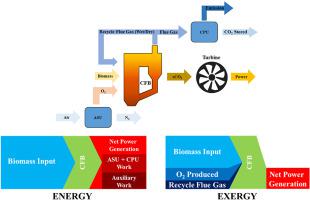当前位置:
X-MOL 学术
›
J. Clean. Prod.
›
论文详情
Our official English website, www.x-mol.net, welcomes your feedback! (Note: you will need to create a separate account there.)
Thermodynamic and exergy assessment of a biomass oxy-fuel combustion with supercritical carbon dioxide cycle under various recycle flue gas conditions
Journal of Cleaner Production ( IF 11.1 ) Pub Date : 2024-05-07 , DOI: 10.1016/j.jclepro.2024.142516 Jester Lih Jie Ling , Han Saem Park , Ha Eun Lee , Bhanupratap S. Solanki , See Hoon Lee
Journal of Cleaner Production ( IF 11.1 ) Pub Date : 2024-05-07 , DOI: 10.1016/j.jclepro.2024.142516 Jester Lih Jie Ling , Han Saem Park , Ha Eun Lee , Bhanupratap S. Solanki , See Hoon Lee

|
The ongoing development of second-generation oxy-fuel combustion system with higher oxygen concentration have presented a potential pathway for efficient biomass utilization. It also signified the meticulous role of recycled flue gas in altering the combustion behaviour in the combustor. Accordingly, investigation into different recirculation modes focusing on recycle ratio, wet/dry conditions, and excess oxygen ratio are conducted with an indirect supercritical power cycle integrated biomass oxy-fuel combustion system. Energy and exergy analyses, as well as composition of flue gas produced are presented. Energy and exergy efficiencies increased with reducing recycle ratio, with respective highest efficiency of 31.33% and 44.37% obtained at excess oxygen ratio of 1.01 and recycle ratio of 0.5 under wet condition. Investigation of CO and HO concentration in produced flue gas depicted a separated stage profile under dry recycle condition, different from the slight diverging profile observed under wet condition when the recycle ratio varied. Concentration of NOx and SOx increased with decreasing recycle ratio and are generally higher under dry condition. Selective exergy analyses of the proposed power cycle presented highest exergy loss in the combustor, followed by the air separation unit, heat exchanger, CO compression and purification unit, and turbine generator. Based on the obtained result, wet recycle flue gas enhanced the combustion performance in the combustor but slightly impaired the convective heat transfer in the heat exchanger. The performance of proposed biomass power cycle is optimized at low recycle ratio of 0.5 under wet recycle condition.
中文翻译:

各种循环烟气条件下超临界二氧化碳循环生物质富氧燃烧的热力学和火用评估
正在开发的具有更高氧气浓度的第二代富氧燃烧系统为高效生物质利用提供了潜在途径。它还表明回收烟气在改变燃烧室的燃烧行为方面发挥着细致的作用。因此,通过间接超临界动力循环集成生物质富氧燃烧系统,对不同的再循环模式进行了研究,重点是再循环率、湿/干条件和过量氧比。介绍了能量和火用分析以及产生的烟气的成分。能量效率和火用效率随着循环比的降低而提高,湿态下过量氧比为1.01、循环比为0.5时效率最高,分别为31.33%和44.37%。对产生的烟气中 CO 和 H2O 浓度的研究描绘了干循环条件下的分离阶段曲线,与湿条件下当循环比变化时观察到的轻微发散曲线不同。 NOx和SOx的浓度随着循环比的降低而增加,并且在干燥条件下通常较高。对拟议动力循环的选择性火用分析表明,燃烧室的火用损失最高,其次是空气分离装置、热交换器、CO 压缩和净化装置以及涡轮发电机。根据所获得的结果,湿循环烟气增强了燃烧器中的燃烧性能,但略微损害了热交换器中的对流换热。所提出的生物质动力循环的性能在湿循环条件下以0.5的低循环比进行优化。
更新日期:2024-05-07
中文翻译:

各种循环烟气条件下超临界二氧化碳循环生物质富氧燃烧的热力学和火用评估
正在开发的具有更高氧气浓度的第二代富氧燃烧系统为高效生物质利用提供了潜在途径。它还表明回收烟气在改变燃烧室的燃烧行为方面发挥着细致的作用。因此,通过间接超临界动力循环集成生物质富氧燃烧系统,对不同的再循环模式进行了研究,重点是再循环率、湿/干条件和过量氧比。介绍了能量和火用分析以及产生的烟气的成分。能量效率和火用效率随着循环比的降低而提高,湿态下过量氧比为1.01、循环比为0.5时效率最高,分别为31.33%和44.37%。对产生的烟气中 CO 和 H2O 浓度的研究描绘了干循环条件下的分离阶段曲线,与湿条件下当循环比变化时观察到的轻微发散曲线不同。 NOx和SOx的浓度随着循环比的降低而增加,并且在干燥条件下通常较高。对拟议动力循环的选择性火用分析表明,燃烧室的火用损失最高,其次是空气分离装置、热交换器、CO 压缩和净化装置以及涡轮发电机。根据所获得的结果,湿循环烟气增强了燃烧器中的燃烧性能,但略微损害了热交换器中的对流换热。所提出的生物质动力循环的性能在湿循环条件下以0.5的低循环比进行优化。






























 京公网安备 11010802027423号
京公网安备 11010802027423号